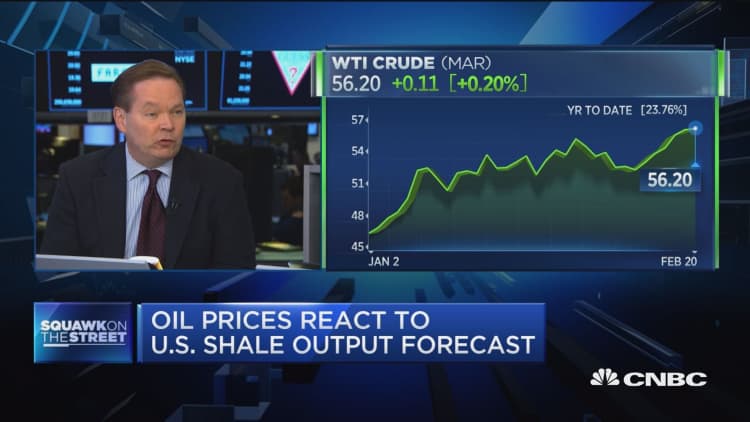Oil prices slipped from 2019 highs on Thursday, as U.S. government data showed a fifth weekly build in crude inventories and record production, while concerns about slowing global economic growth weighed.
Losses were capped by OPEC-led supply cuts and U.S. sanctions on Venezuela and Iran. Advancements in Washington-Beijing trade deal discussions also supported prices.
U.S. West Texas Intermediate crude oil futures ended Thursday's session 20 cents lower at $56.96 a barrel. WTI hit a fresh three-month high of $57.61 earlier in the day.
Brent crude futures fell by 13 cents to $66.95 around 2:25 p.m. ET, after touching a 2019 peak on Wednesday at $67.38.

U.S. crude oil stockpiles rose to the highest in more than a year, as production hit a record high and seasonal maintenance kept refining rates low last week, the Energy Information Administration said.
U.S. crude stocks rose 3.7 million barrels in the week to Feb. 15, to 454.5 million barrels, the highest since October 2017, even as crude exports surged 1.2 million barrels per day to a record 3.6 million bpd.
"All in all the report is bearish, in particular the strong increases in crude oil stocks," said Cartsen Fritsch, analyst at Commerzbank in Frankfurt.
Production in the United States, which last year became the world's top crude producer, rose to record high at 12 million bpd, which could also dampen sentiment, Fritsch said.
Still, tightening supply globally helped keep losses at bay.
Oil prices have been driven up this year after the Organization of the Petroleum Exporting Countries and producer allies such as Russia, known as OPEC+, agreed to cut output by 1.2 million barrels per day (bpd) to prevent a supply overhang from growing.
OPEC member Nigeria signalled on Wednesday that it would limit output after its production climbed in January.

"Willingness of the OPEC+ group to adhere with the output cut agreement will remain supportive of oil prices in the run-up to their scheduled April meeting," said Abhishek Kumar, senior energy analyst at Interfax Energy in London.
"Sharply declining oil output from Iran and Venezuela will further prompt bullish sentiment in the market."
U.S. sanctions have hit Iranian and Venezuelan crude exports while unrest has curbed Libyan output.
Talks between the United States and China to resolve a trade dispute which has dented global growth may be progressing, helping to lift crude prices.
The two sides have started to outline commitments in principle on key points of contention, sources familiar with the negotiations told Reuters.
However, analysts said that a global economic slowdown — signs of which emerged late last year — was preventing prices from surging beyond highs reached this week.
— CNBC's Tom DiChristopher contributed to this report.

